1994 CHEVROLET CORVETTE steering wheel
[x] Cancel search: steering wheelPage 130 of 274
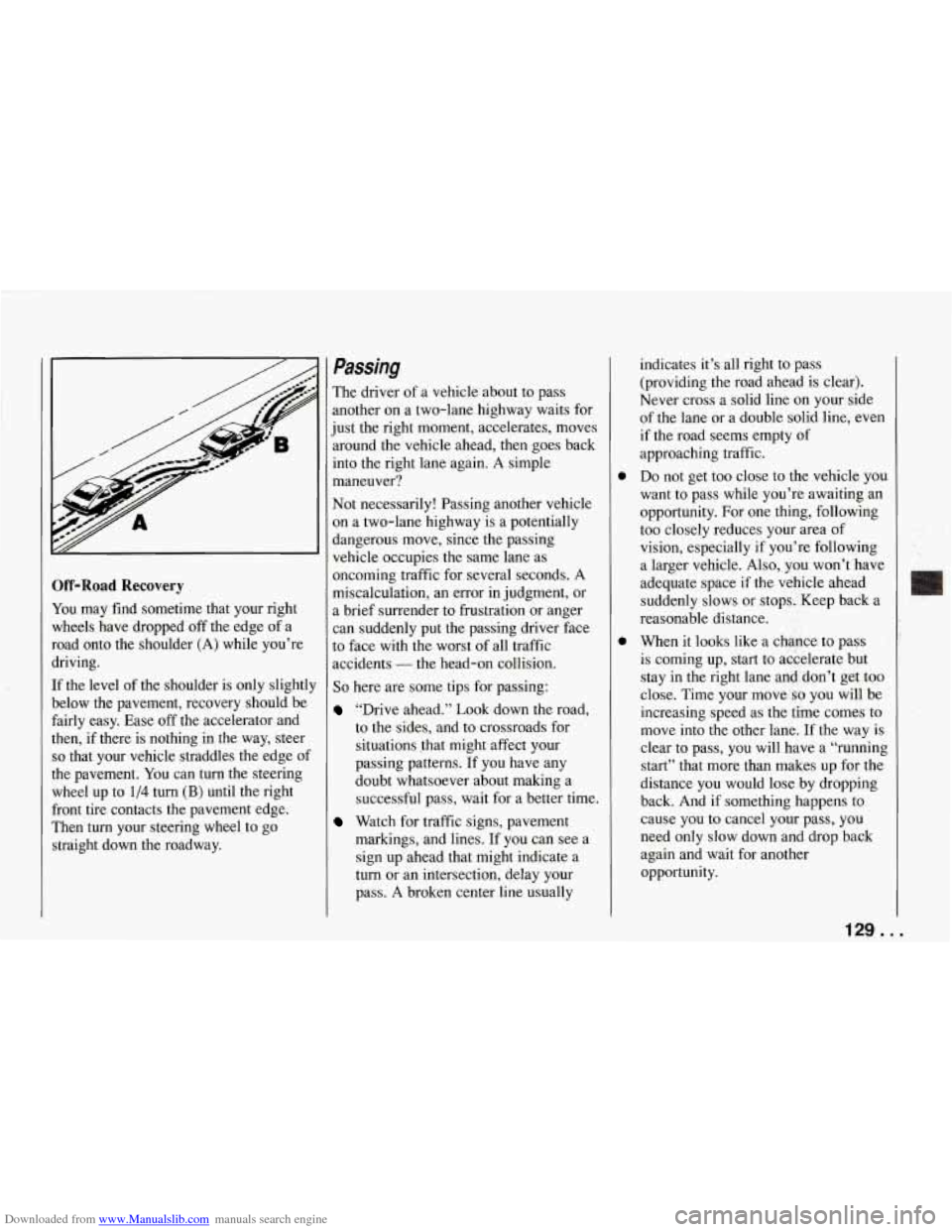
Downloaded from www.Manualslib.com manuals search engine Off-Road Recovery
You may find sometime that your right
wheels have dropped off the edge of a
road onto the shoulder (A) while you’re
driving.
If the level of the shoulder is only slight11
below the pavement, recovery should be
fairly easy. Ease off the accelerator and
then,
if there is nothing in the way, steer
so that your vehicle straddles the edge of
the pavement.
You can turn the steering
wheel up to
1/4 turn (B) until the right
front tire contacts the pavement edge.
Then turn your steering wheel to
go
straight down the roadway.
Passing
fhe driver of a vehicle about to pass
mother on a two-lane highway waits for
ust the right moment, accelerates, moves
tround the vehicle ahead, then goes back
.nto the right lane again.
A simple
naneuver?
Vot necessarily! Passing another vehicle
In a two-lane highway is a potentially
langerous move, since the passing
fehicle occupies the same lane as
Incoming traffic for several seconds. A
niscalculation, an error in judgment, or
brief surrender to frustration or anger
:an suddenly put the passing driver face
:o face with the worst of all traffic
lccidents
- the head-on collision.
So here are some tips for passing:
“Drive ahead.” Look down the road,
to the sides, and
to crossroads for
situations that might affect your
passing patterns. If you have any
doubt whatsoever about making a
successful pass, wait for a better time.
Watch for traffic signs, pavement
markings, and lines. If you can see a
sign up ahead that might indicate a
turn or an intersection, delay your
pass. A broken center line usually indicates
it’s all right to pass
(providing the road ahead
is clear).
Never cross a solid line on your side
of the lane or a double solid line, even
if the road seems empty of
approaching traffic.
Do not get too close to the vehicle you
want to pass while you’re awaiting an
opportunity. For one thing, following
too closely reduces your area of
vision, especially if you’re following
a larger vehicle. Also, you won’t have
adequate space if the vehicle ahead
suddenly slows or stops. Keep back a
reasonable distance.
When it looks like a chance to pass
is coming up, start to accelerate but
stay in the right lane and don’t get too
close. Time your move
so you will be
increasing speed as the time comes to
move into the other lane. If the way is
clear to pass, you will have a “running
start” that more than makes up for the
distance you would lose by dropping
back. And if something happens to
cause you to cancel your pass, you
need only slow down and drop back
again and wait for another
opportunity.
Page 131 of 274
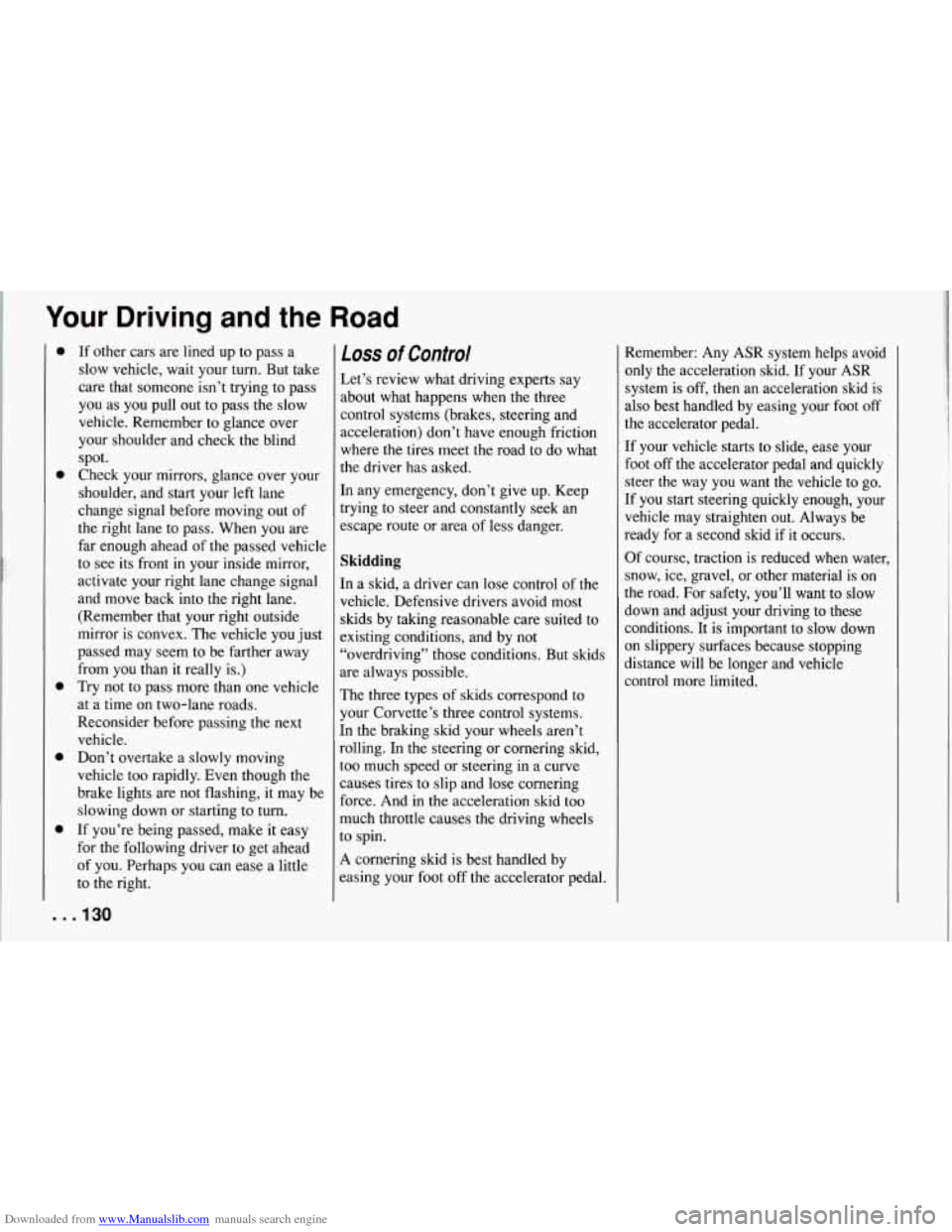
Downloaded from www.Manualslib.com manuals search engine Your Driving and the Road
0
0
..
If other cars are lined up to pass a
slow vehicle, wait your turn. But take
care that someone isn’t trying to pass
you as you pull out to pass the slow
vehicle. Remember to glance over
your shoulder and check the blind
spot.
Check your mirrors, glance over your
shoulder, and start your left lane
change signal before moving out of
the right lane to pass. When you are
far enough ahead
of the passed vehicle
to see its front
in your inside mirror,
activate your right lane change signal
and move back into the right lane.
(Remember that your right outside
mirror is convex. The vehicle you just
passed may seem to be farther away
from you than it really is.)
Try not to pass more than one vehicle
at a time on two-lane roads.
Reconsider before passing the next vehicle.
Don’t overtake a slowly moving
vehicle too rapidly. Even though the
brake lights are not flashing, it may be
slowing down or starting
to turn.
If you’re being passed, make it easy
for the following driver to get ahead
of you. Perhaps you can ease a little
to the right.
,130
Loss of Control
Let’s review what driving experts say
about what happens when the three
control systems (brakes, steering and
acceleration) don’t have enough friction
where the tires meet the road to do what
the driver has asked.
In any emergency, don’t give up. Keep
trying to steer and constantly seek an
escape route or area of less danger.
Skidding
In a skid, a driver can lose control of the
vehicle. Defensive drivers avoid most
skids by taking reasonable care suited to
existing conditions, and by not
“overdriving” those conditions. But skids
are always possible.
The three types of skids correspond to
your Corvette’s three control systems.
In the braking skid your wheels aren’t
rolling. In the steering or cornering skid,
too much speed or steering in a curve
causes tires to slip and lose cornering
force. And in the acceleration skid too
much throttle causes the driving wheels
to spin.
A cornering skid
is best handled by
easing your foot
off the accelerator pedal. Remember: Any
ASR system helps avoid
only the acceleration skid. If your ASR
system is
off, then an acceleration skid is
also best handled by easing your foot off
the accelerator pedal.
If your vehicle starts to slide, ease your
foot
off the accelerator pedal and quickly
steer the way you want the vehicle to go.
If you start steering quickly enough, your
vehicle may straighten out. Always be
ready for a second skid if it occurs.
Of course, traction is reduced when water,
snow, ice, gravel, or other material is on
the road. For safety, you’ll want to slow
down and adjust your driving to these
conditions. It is important to slow down
on slippery surfaces because stopping
distance will be longer and vehicle
control more limited.
Page 148 of 274
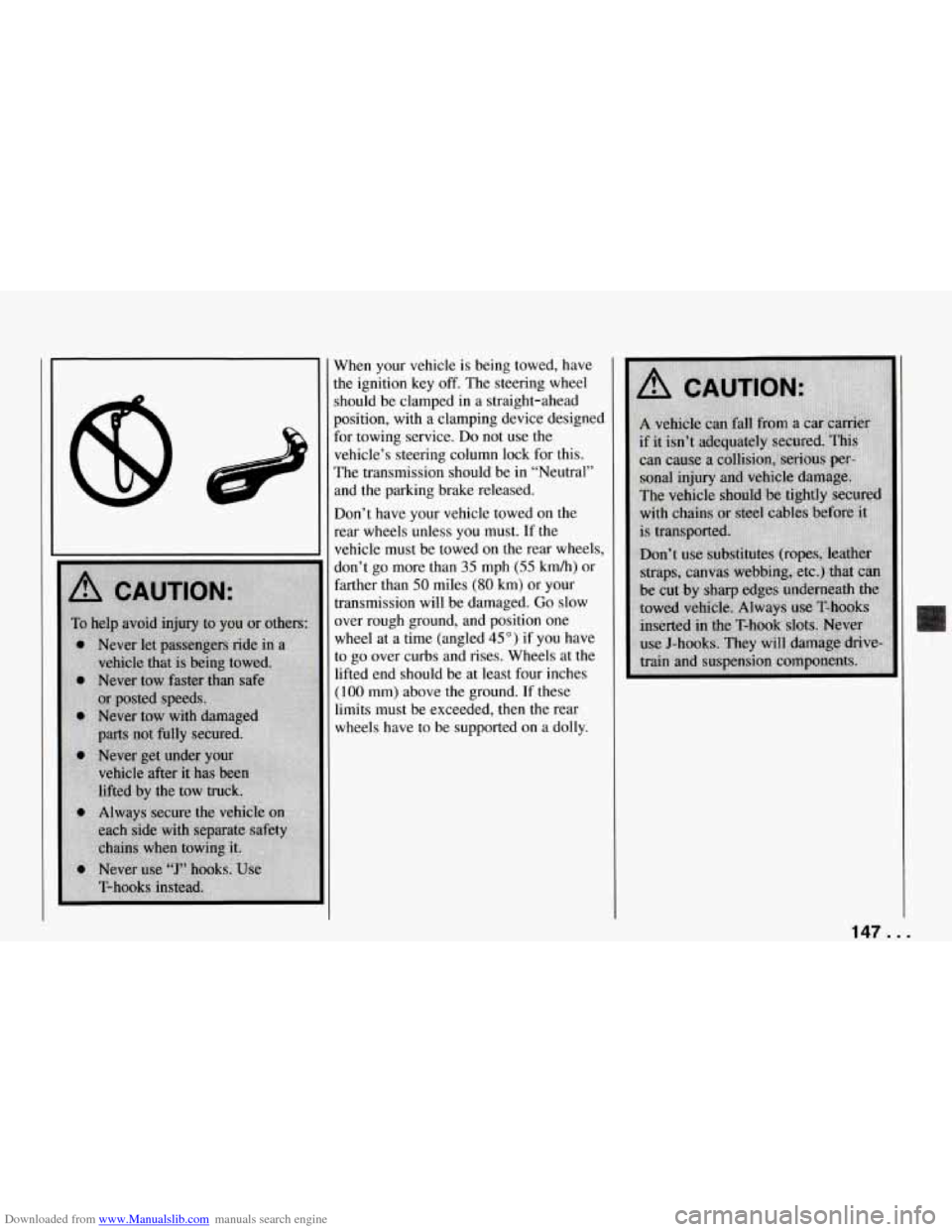
Downloaded from www.Manualslib.com manuals search engine IC
When your vehicle is being towed, have
he ignition key
off. The steering wheel
should be clamped in a straight-ahead
position, with a clamping device designed
For towing service.
Do not use the
vehicle’s steering column lock for this.
The transmission should be in “Neutral”
and the parking brake released.
Don’t have your vehicle towed
on the
rear wheels unless you must. If the
vehicle must be towed on the rear wheels,
don’t go more than
35 mph (55 kmh) or
farther than
50 miles (80 km) or your
transmission will be damaged.
Go slow
mer rough ground, and position one
wheel at a time (angled
45”) if you have
to go over curbs and rises. Wheels at the
lifted end should be at least four inches
(1 00 mm) above the ground. If these
limits must be exceeded, then the rear
wheels have to be supported
on a dolly.
14f ...
Page 160 of 274

Downloaded from www.Manualslib.com manuals search engine 8. Shut the engine off and replace the
pressure cap. At any time during this
procedure if coolant begins
to flow
out
of the filler neck, reinstall the
pressure cap. Be sure the arrows on
the cap line up like this.
If a Tire Goes Flat
It’s unusual for a tire to “blow out” while
you’re driving, especially if you maintain
your tires properly. If air goes out of a
tire, it’s much more likely
to’ leak out
slowly. But
if you should ever have a
”blowout,” here are a few tips about
what to expect and what to do:
If a front tire fails, the flat tire will create
a drag that pulls the vehicle toward that
side. Take your foot off the accelerator
pedal and grip the steering wheel firmly.
Steer
to maintain lane position, then
gently brake to a stop well out of the
traffic lane.
A rear blowout, particularly on a curve,
acts much like a skid and may require the
same correction you’d use in a skid. In
any rear blowout, remove your foot from
the accelerator pedal. Get the vehicle
under control by steering the way you
want the vehicle to go.
It may be very
bumpy and noisy, but you can still steer.
Gently brake to a stop, well qff the road
if possible.
If a tire goes flat, the next section shows
how to use your jacking equipment to
change a flat tire safely. If your vehicle
has Extended Mobility Tires (tires with
“EMT” molded on the sidewalls), see
“Extended Mobility Tires” in the Index.
Changing a Flat Tire
If a tire goes flat, avoid further tire
damage by driving slowly to a level place.
Turn on your hazard warning flashers.
159 ...
Page 171 of 274
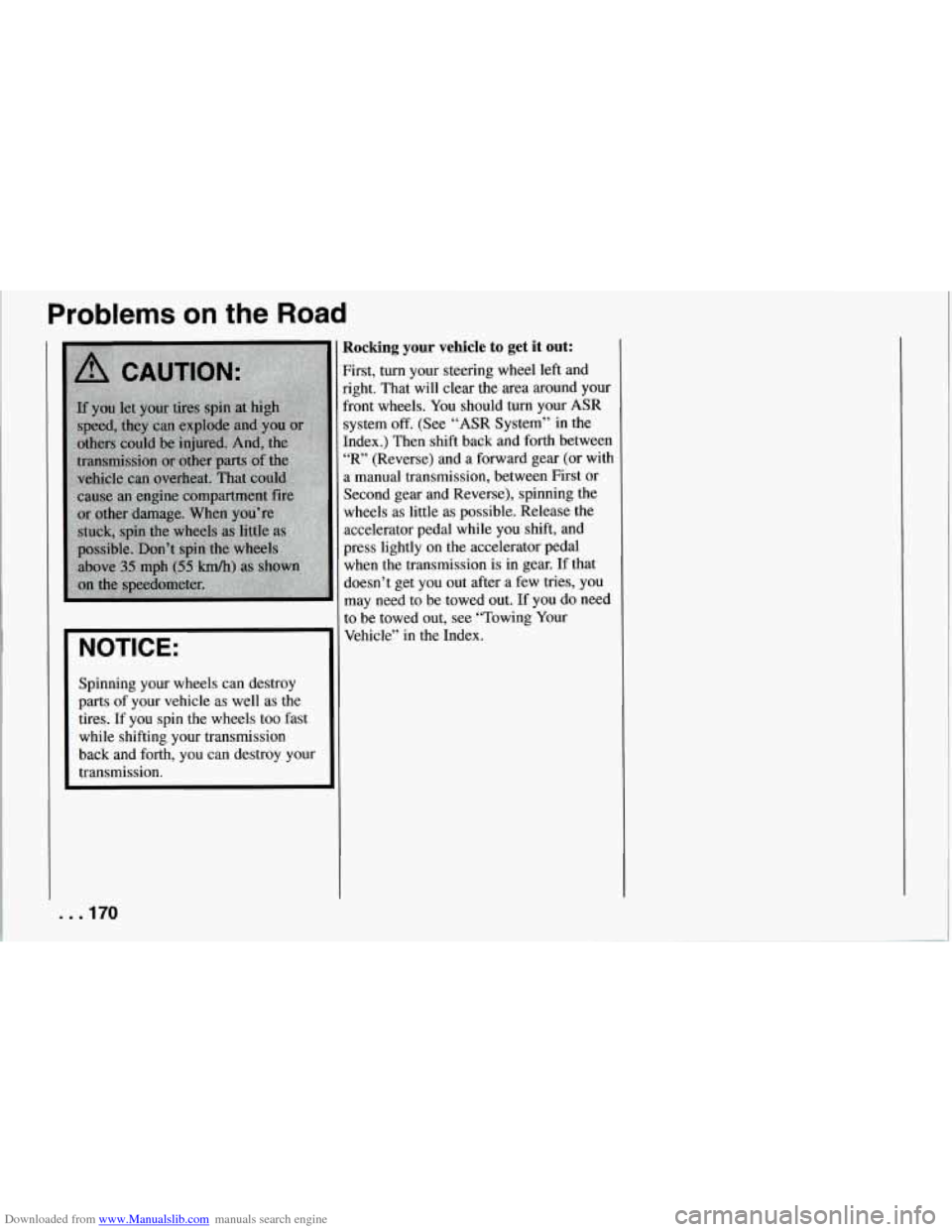
Downloaded from www.Manualslib.com manuals search engine Problems on the Road
NOTICE:
Spinning your wheels can destroy
parts of your vehicle as well as the
tires. If you spin the wheels too fast
while shifting your transmission
back and forth, you can destroy your
transmission.
. . .I70
Rocking your vehicle to get it out:
First, turn your steering wheel left and
ight. That will clear the area around your
front wheels. You should
turn your ASR
system
off. (See “ASR System” in the
[ndex.) Then shift back and forth between
“R’ (Reverse) and a forward gear (or with
9 manual transmission, between First or
Second gear and Reverse), spinning the
wheels as little as possible. Release the
accelerator pedal while you shift, and
press lightly on the accelerator pedal
when the transmission is in gear. If that
doesn’t get you out after a few tries, you
may need to be towed out.
If you do need
to be towed out, see “Towing Your
Vehicle” in the Index.
Page 243 of 274
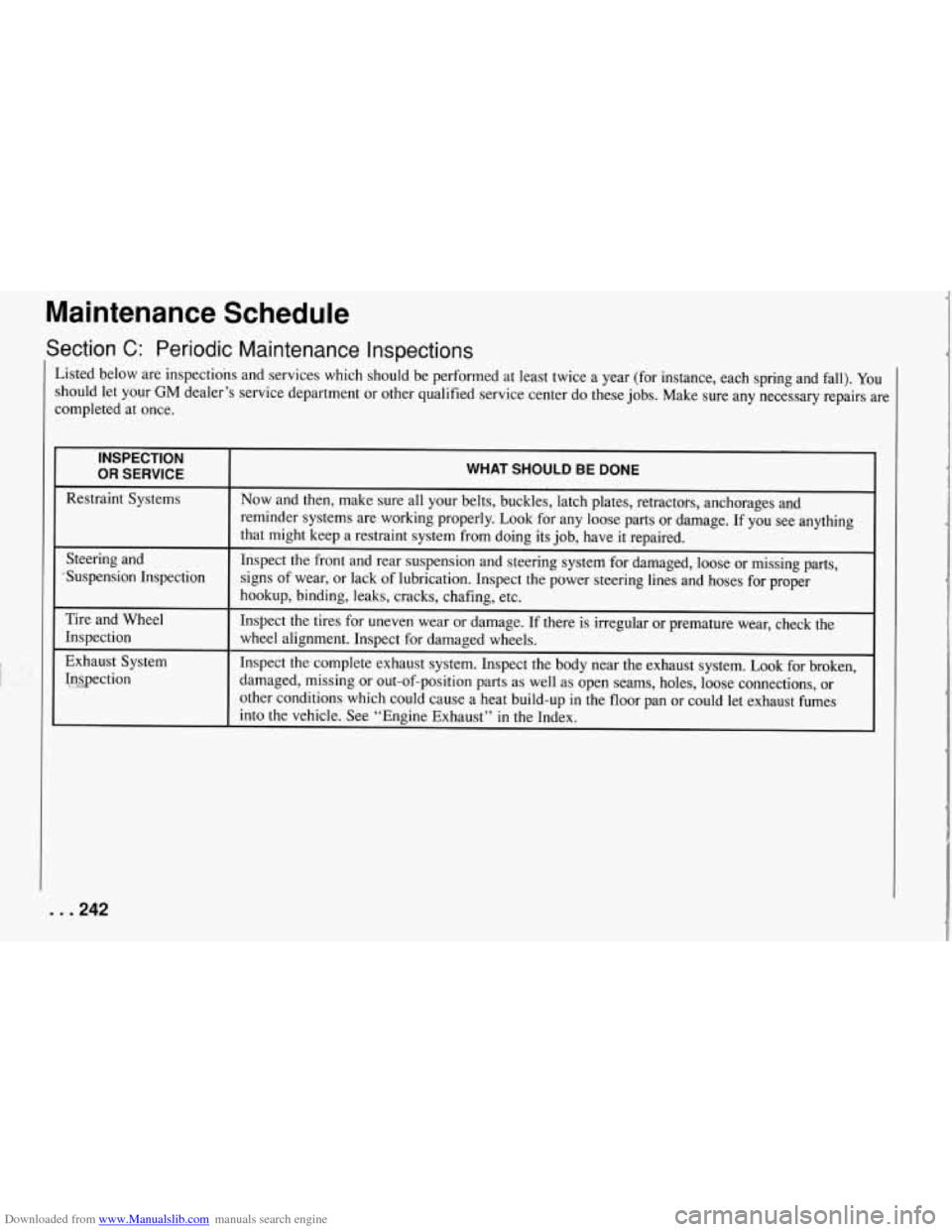
Downloaded from www.Manualslib.com manuals search engine Maintenance Schedule
I Section C: Periodic Maintenance Inspections
I
S
isted below are inspections and services which should be performed at least twice a year (for instance, each spring and fall). You
hould let your GM dealer’s service department or other qualified service center do these jobs. Make sure any necessary repairs are
ompleted at once.
INSPECTION
OR SERVICE
Restraint Systems
Steering and
‘Suspension Inspection
Tire and Wheel Inspection
Exhaust System
Inaection
. .242
WHAT SHOULD BE DONE
Now and then, make sure all your belts, buckles, latch plates, retractots, anchorages and
reminder systems are working properly.
Look for any loose parts or damage. If you see anything
that might keep a restraint system from doing its job, have
it repaired.
Inspect the front and rear suspension and steering systenl for damaged, loose or missing parts,
signs of wear, or lack
of lubrication. Inspect the power steering lines and hoses for proper
hookup, binding, leaks, cracks, chafing, etc.
Inspect the tires for uneven wear or damage. If there is irregular or premature wear, check
the
wheel alignment. Inspect for damaged wheels.
Inspect the complete exhaust system. Inspect the body near the \
exhaust system.
Look for broken,
damaged, missing or out-of-position parts as well as open seams, holes, loose connections, or
other conditions which could cause a heat build-up in
the floor pan or could let exhaust fumes
into the vehicle. See “Engine Exhaust”
in the Index.
Page 269 of 274
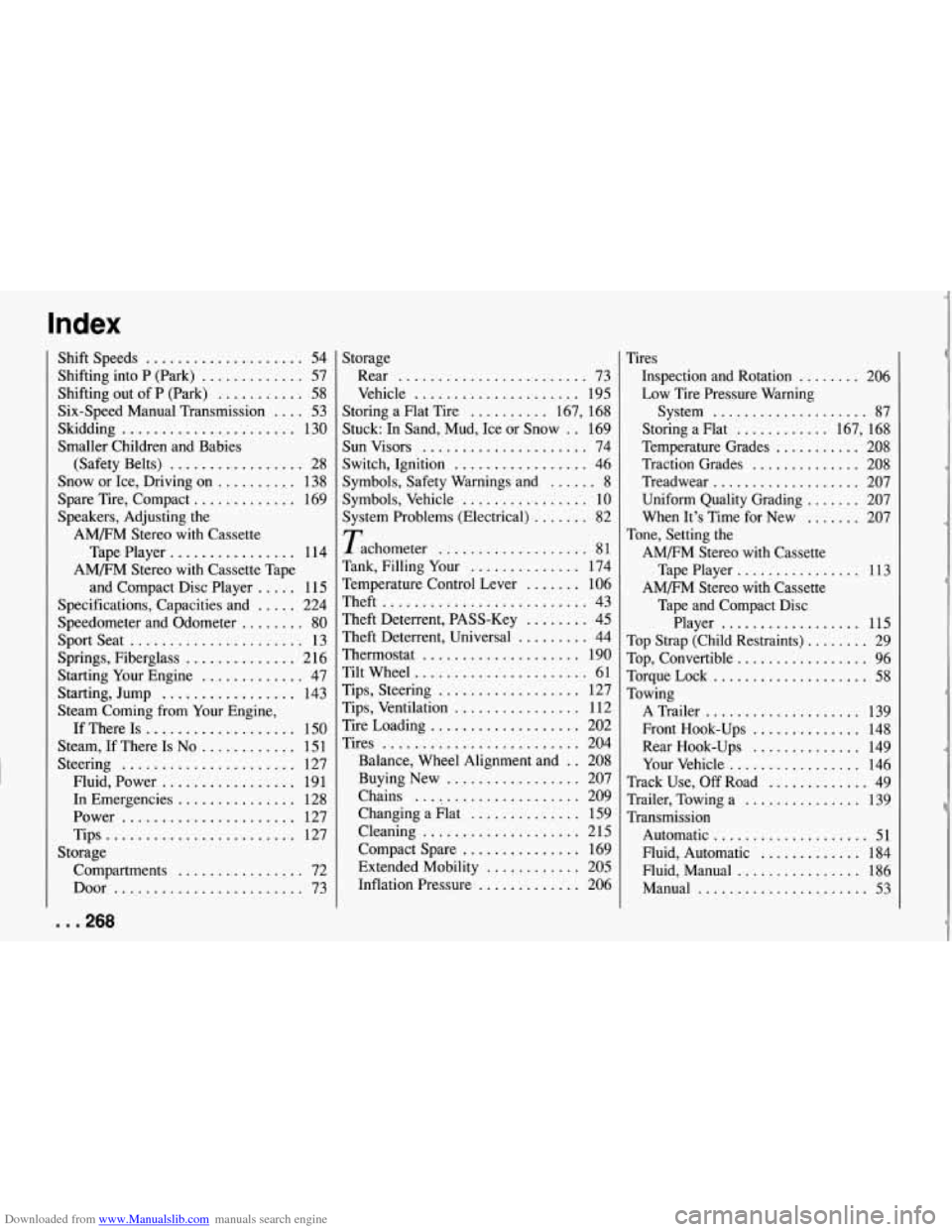
Downloaded from www.Manualslib.com manuals search engine Index
Shift Speeds .................... 54
Shifting into P (Park)
............. 57
Shifting out of P (Park)
........... 58
Six-Speed Manual Transmission
.... 53
Skidding
...................... 130
Smaller Children and Babies
(Safety Belts)
................. 28
Snow or Ice. Driving on
.......... 138
Spare Tire. Compact
............. 169
Speakers. Adjusting the
AM/FM Stereo with Cassette
AM/FM Stereo with Cassette Tape
Tape Player
................ 114
and Compact Disc Player
..... 11 5
Specifications. Capacities and
..... 224
Speedometer and Odometer
........ 80
Sport Seat ...................... 13
Springs. Fiberglass
.............. 21 6
Starting Your Engine
............. 47
Starting. Jump
................. 143
Steam Coming from Your Engine.
If There Is
................... 150
Steam. If There Is No
............ 151
Steering
...................... 127
Fluid. Power
................. 191
In Emergencies
............... 128
Power
...................... 127
Tips
........................ 127
Compartments
................ 72
Door
........................ 73
Storage
... 268
Storage
Rear
........................ 73
Vehicle
..................... 195
Storing a Flat Tire
.......... 167. 168
Stuck: In Sand. Mud. Ice or Snow . . 169
Sun Visors
..................... 74
Switch. Ignition
................. 46
Symbols. Safety Warnings and
...... 8
Symbols. Vehicle ................ 10
System Problems (Electrical)
....... 82
Tachometer
................... 8 1
Tank. Filling Your
.............. 174
Temperature Control Lever
....... 106
Theft
.......................... 43
Theft Deterrent. PASS-Key
........ 45
Theft Deterrent. Universal
......... 44
Thermostat
.................... 190
Tilt Wheel
...................... 61
Tips, Steering
.................. 127
Tips. Ventilation
................ 1 12
Tire Loading
................... 202
Tires
......................... 204
Balance. Wheel Alignment and
. . 208
Buying New
................. 207
Chains
..................... 209
Changing a Flat
.............. 159
Cleaning
.................... 2 1 5
Compact Spare ............... 169
Extended Mobility
............ 205
Inflation Pressure
............. 206 Tires
Inspection and Rotation
........ 206
Low Tire Pressure Warning System
.................... 87
Storing a Flat
............ 167. 168
Temperature Grades
........... 208
Traction Grades
.............. 208
Treadwear
................... 207
When It’s Time for New
....... 207
AM/FM Stereo with Cassette
AM/FM Stereo with Cassette Tape and Compact Disc
Uniform Quality Grading
....... 207
Tone. Setting the
Tape Player
................ 11 3
Player .................. 115
Top. Convertible
................. 96
Torque Lock
.................... 58
Towing A Trailer
.................... 139
Top
Strap (Child Restraints)
........ 29
Front Hook-Ups
.............. 148
Rear Hook-Ups
.............. 149
Your Vehicle
................. 146
Track Use.
Off Road ............. 49
Trailer. Towing a
............... 139
Transmission
Automatic
.................... 51
Fluid. Automatic
............. 184
Fluid. Manual
................ 186
Manual
...................... 53